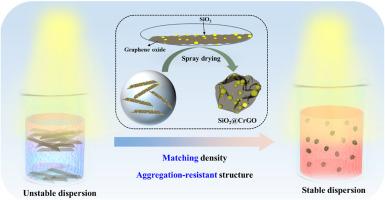Self-dispersible SiO2@CrGO molten salt nanofluids for medium-temperature direct absorption solar-thermal energy harvesting
IF 6.3
2区 材料科学
Q2 ENERGY & FUELS
引用次数: 0
Abstract
Molten salt nanofluids have emerged as an appealing medium for direct absorption-based harvesting of solar-thermal energy at elevated temperatures. Most often, however, molten salt nanofluids suffer from poor dispersion stability and tend to aggregate, which is challenging to solve with conventional stabilization approaches. In this work, we report the preparation of crumpled hybrid SiO2@CrGO particles that are self-dispersible within molten salts for direct absorption-based medium-temperature solar-thermal energy harvesting. The crumpled hybrid SiO2@CrGO particles were synthesized through attaching SiO2 nanoparticles onto GO sheets with silane coupling agents followed by a one-step aerosol drying process. By controlling the loading of SiO2 particles, the hybrid SiO2@CrGO particles possess crumpled rough surface structure and an appropriate density matching with the molten salt fluids. Such features simultaneously suppress interparticle van der Waals attraction and gravitational sedimentation or buoyancy-induced floating, which in turn enable stable homogeneous dispersion of the nanofluids after continuous heating at 200 °C for 30 days and concentrated solar illumination. In comparison with neat molten salts, the SiO2@CrGO nanofluids have demonstrated long-term stable uniform dispersion, significantly increased solar absorptance, slightly enhanced specific heat capacity and largely same solid-liquid phase change behavior, which enabled consistent direct absorption of concentrated solar illumination as renewable heat at 200 °C. It is expected that this work provides a facile and effective strategy to overcome the long-lasting dispersion stability issue of molten salt nanofluids and stimulate their diverse applications.

用于中温直接吸收太阳热能的自分散 SiO2@CrGO 熔盐纳米流体
熔盐纳米流体已成为在高温条件下以直接吸收为基础收集太阳热能的一种极具吸引力的介质。然而,大多数情况下,熔盐纳米流体的分散稳定性较差,容易聚集,这是用传统稳定方法难以解决的问题。在这项工作中,我们报告了在熔盐中可自我分散的皱褶混合 SiO2@CrGO 粒子的制备方法,这种粒子可用于基于直接吸收的中温太阳热能收集。这种皱褶混合 SiO2@CrGO 粒子是用硅烷偶联剂将 SiO2 纳米颗粒附着在 GO 片上,然后通过一步气溶胶干燥工艺合成的。通过控制 SiO2 颗粒的负载量,SiO2@CrGO 混合颗粒具有皱褶粗糙的表面结构,并与熔盐流体具有适当的密度匹配。这些特点同时抑制了颗粒间的范德华吸引和重力沉降或浮力引起的漂浮,从而使纳米流体在 200 °C 持续加热 30 天和太阳光集中照射后能够稳定均匀地分散。与纯熔盐相比,SiO2@CrGO 纳米流体表现出长期稳定的均匀分散性,太阳能吸收率显著提高,比热容略有增强,固液相变行为基本相同,可在 200 ℃ 下持续直接吸收太阳光作为可再生热量。这项工作有望为克服熔盐纳米流体的长期分散稳定性问题和促进其多样化应用提供一种简便而有效的策略。
本文章由计算机程序翻译,如有差异,请以英文原文为准。
求助全文
约1分钟内获得全文
求助全文
来源期刊

Solar Energy Materials and Solar Cells
工程技术-材料科学:综合
CiteScore
12.60
自引率
11.60%
发文量
513
审稿时长
47 days
期刊介绍:
Solar Energy Materials & Solar Cells is intended as a vehicle for the dissemination of research results on materials science and technology related to photovoltaic, photothermal and photoelectrochemical solar energy conversion. Materials science is taken in the broadest possible sense and encompasses physics, chemistry, optics, materials fabrication and analysis for all types of materials.
 求助内容:
求助内容: 应助结果提醒方式:
应助结果提醒方式:


